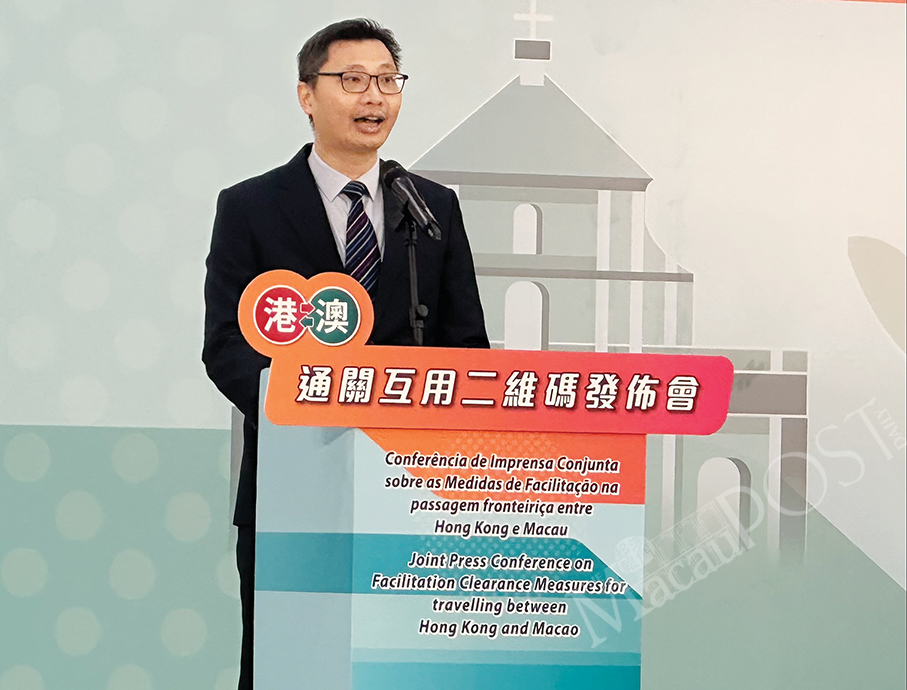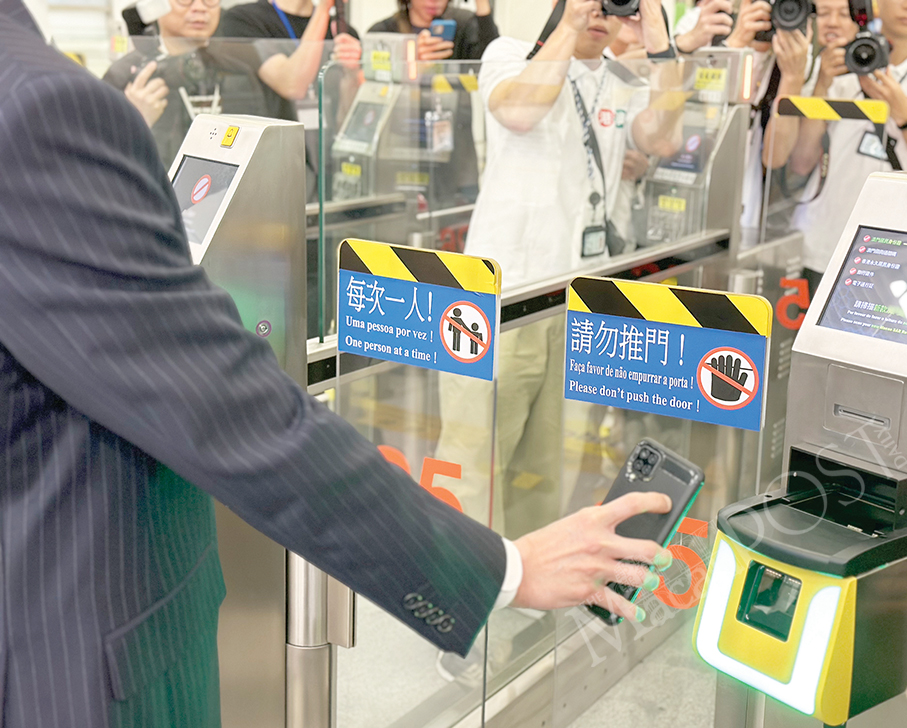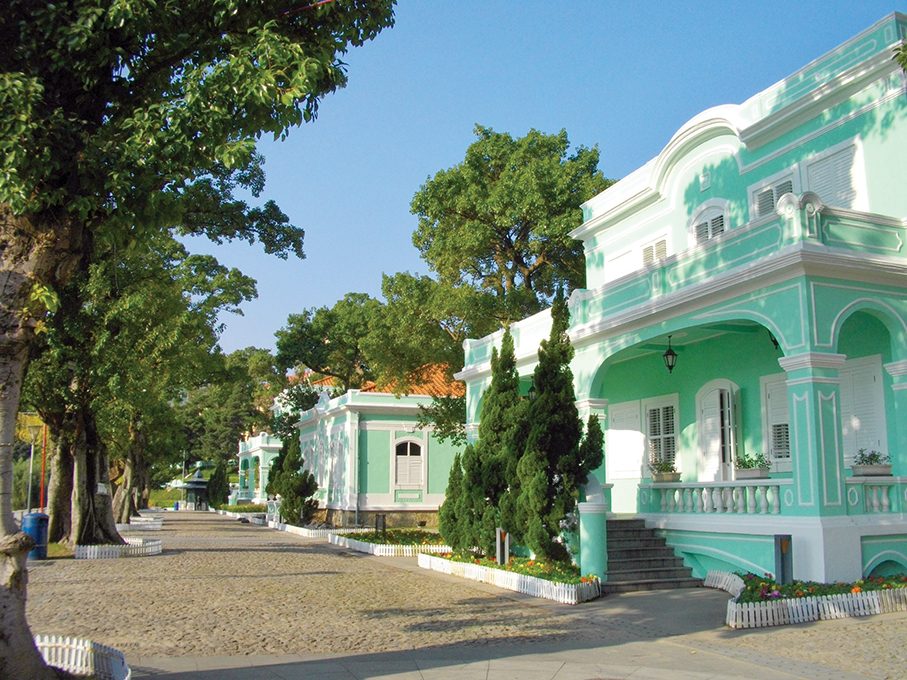Starting today, permanent residents of Macau and Hong Kong aged at least 11 can use their QR codes between the two special administrative regions’ (SARs) clearance service generated by their respective mobile apps, i.e., “Macao One Account” for the former and “Contactless e-Channel” for the latter, to cross border checkpoints between the two cities through e-channels.
Upon the commencement of the new measure, eligible residents of the two places may choose to cross the border with their respective QR code or physical ID card.
Public Administration and Civil Service Bureau (SAFP) Director Ng Wai Han said during a joint press conference yesterday that as of the end of May, nearly 300,000 local residents have enrolled to use Hong Kong’s e-Channels, while, according to Benson Kwok Joon-fung, director of Hong Kong’s Immigration Department, the number of Hong Kong residents registered to use Macau’s automated passenger clearance stands at nearly 2.5 million.
According to yesterday’s press conference at the Macau checkpoint of the Hong Kong-Zhuhai-Macau Bridge (HZMB), the “Mutual Use of QR Code between HKSAR and Macao SAR Clearance Service” is applicable to holders of a Macau permanent ID card or Hong Kong permanent ID card, as well as a Hong Kong ID card marked with “*”, “* **” and “R”, aged 11 or above who have registered to use e-Channels and the Automated Passenger Clearance Service in Hong Kong and Macau respectively, in which Macau residents will be able to generate their QR code via the “My border crossing” function after updating their “Macao One Account”. Ng underlined during the press conference that under the existing laws of Hong Kong, Macau residents are still required to carry their physical ID card when entering Hong Kong – and vice versa.
Delivering a speech during the press conference, Identification Services Bureau (DSI) Director Chao Wai Ieng said that the new measure will further optimise the immigration clearance process and enhance the convenience of cross-border travel for residents of the two places, facilitating the exchange and movement of people as well as economic ties and trade between the two cities, while further developing Macau’s cultural tourism, convention and exhibition industry as well as its other “1+4” key nascent industries (big health, modern finance and high-tech) with a view to creating a high-quality residential conurbation in the Guangdong-Zhuhai-Macau Greater Bay Area (GBA). Kwok, on the other hand, pointed out in his speech that Macau is one of the most popular places for Hong Kong residents to visit, with three million passenger trips made using e-channels in the first half of this year alone, adding that the new measure will further enhance the quality of the immigration services of the two places to tie in with the nation’s major strategy for the GBA development.
Chao said that the new measure is currently applicable to the two cities’ permanent residents: “The first phase targets permanent residents of Hong Kong and Macau, mainly based on the principle of reciprocity. As for non-permanent residents, we will liaise closely with the Hong Kong side in the next phase and strive to complete the work in due course before making an announcement”.
In terms of Personal Data Protection, Ng said that the new measure has been launched based on existing cooperation with Hong Kong’s e-channel services, in which the whole process is registered by Macau residents on a voluntary basis with their specific consent, i.e., they have agreed to give their identity information to the Hong Kong side for registration in accordance with the law, stressing that both the QR codes and data storage are in compliance with Macau’s cybersecurity standards and requirements in line with the city’s Personal Data Law and cybersecurity procedures.
E-Channel services registration
Meanwhile, according to Ng, local permanent residents aged 18 or above can register to use Hong Kong’s e-Channel via the self-service kiosks at the city’s seven 24-hour government self-service centres on Avenida de Sidónio Pais, in China Plaza on Avenida da Praia Grande, the Government Services Centre in Areia Preta, Fai Tat Building in Fai Chi Kei district in the peninsula and at the Government Islands Services Centre and the Lago (Lake) public housing estate in Taipa, as well as at the Seac Pai Van Community Complex in Coloane. Registration can also be done at the Government Affairs Service Centre in the Guangdong-Macau In-depth Cooperation Zone in Hengqin.
Ng noted that Macau permanent residents aged between 11 and 17 must, accompanied by their parents or guardians, complete their application at the e-Channel registration offices at the Hong Kong Immigration Department Headquarters, HK-China Tsim Sha Tsui Ferry Terminal checkpoint, Sheung Wan HK-Macau Ferry Terminal checkpoint, Kai Tak Cruise Terminal checkpoint, and Hong Kong-Zhuhai-Macau Bridge checkpoint.

Identification Services Bureau (DSI) Director Chao Wai Ieng delivers a speech during yesterday’s press conference about the “Mutual Use of QR Code between HKSAR
and Macao SAR Clearance Service”, at Macau’s checkpoint of the Hong Kong-Zhuhai-Macau Bridge (HZMB).

A Hong Kong official demonstrates how to use the QR code generated for crossing the border checkpoint after yesterday’s press conference at the Macau checkpoint of the Hong Kong-Zhuhai-Macau Bridge (HZMB). – Photos: Yuki Lei







